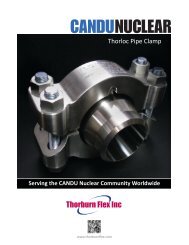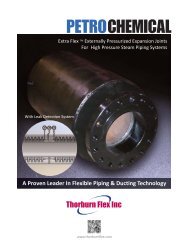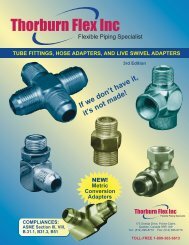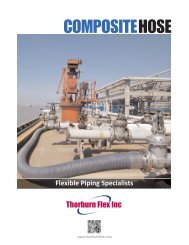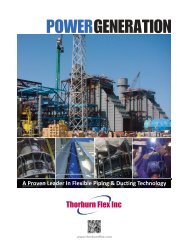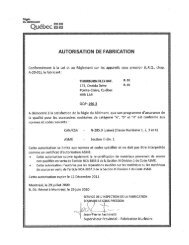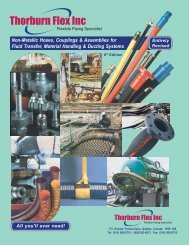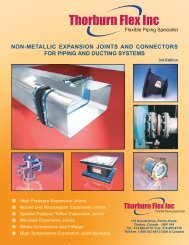Metallic Expansion Joints - Thorburn Flex Inc
Metallic Expansion Joints - Thorburn Flex Inc
Metallic Expansion Joints - Thorburn Flex Inc
You also want an ePaper? Increase the reach of your titles
YUMPU automatically turns print PDFs into web optimized ePapers that Google loves.
THORBURN<br />
FLEXIBLE PIPING SPECIALIST<br />
ACCESSORIES<br />
CONTROL RODS<br />
Control rods are utilized to prevent excessive displacement of the bellows in a<br />
universal expansion joint. These rods also control the relatively free centerspool<br />
between the two bellows. These rods are not designed to restrain pressure<br />
thrust forces.<br />
TWO-PLY TESTABLE EXPANSION JOINT<br />
The purpose of the 2-ply testable bellows is to provide a safety ply design. Each<br />
bellows ply is designed to withstand the system design pressure independently,<br />
so that in the event one ply fails for any reason, the remaining ply will enable the<br />
expansion joint to continue to function in a normal condition. The space between<br />
the bellows plies can be connected to a pressure gauge or a continuous<br />
monitoring system. It would register any change in pressure and thus trigger<br />
action to program replacement of the expansion joint on a routine basis.<br />
TOROIDAL EXPANSION JOINT<br />
Toroidal expansion joints are used in very high pressure systems. This type of<br />
construction transmits most of the hoop loading from the convolutions to the<br />
adjacent rings. This design allows relatively thin bellows to accept very high<br />
pressures.<br />
MULTI-PLY BELLOWS<br />
Multi-ply bellows construction is used when increased fatigue life and lower forces<br />
are required while still maintaining the same pressure capacity. The multiple plies<br />
act in unison as far as hoop pressure loading is concerned, but act individually<br />
when fatigue life and forces are calculated. <strong>Thorburn</strong> can also manufacture multiply<br />
bellows with varying materials. This is especially useful when the media dictates<br />
a material for corrosion protection, but one that is not strong enough to take the<br />
pressure loading. This type of construction allows <strong>Thorburn</strong> to supply the most<br />
economic bellows of optimum design for any individual application. Small holes<br />
are drilled into the outer ply cuffs of a multi-ply bellows to provide for expansion of<br />
entrapped air between the plies during high temperature operation.<br />
HEAVY WALL BELLOWS<br />
As a result of significantly improved fabrication capabilities, <strong>Thorburn</strong> now offers heavy wall single ply bellows to 3/16 of an inch (.187<br />
inches, 4.76 mm) thickness and convolution heights ranging to 15 inches. These bellows possess reasonable spring forces as a result<br />
of the high convolution configuration.<br />
Bellows of this thickness quite often enable maintenance personnel to make temporary weld repairs, in many cases without system<br />
shutdown. Such repairs might allow the system to continue to operate until a regularly scheduled shutdown occurs.<br />
Heavy wall bellows are less susceptible to damage during installation and systems start-up. Multiple-ply bellows are available to a<br />
thickness of 1/4 inch (.250 inches – 6.35 mm).<br />
Page 7





